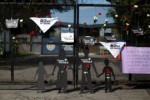Military's use of toxic 'forever chemicals' leaves lasting scars
This excerpt comes from the forthcoming book Poisoning the Well: How Forever Chemicals Contaminated America, which details how a set of toxic compounds have devastated entire communities across the country. It has been edited for length and clarity.
Colorado Springs and its suburbs in El Paso County are surrounded not only by natural wonders like the Garden of the Gods, a massive park filled with red rock formations, but also several military installations, including Peterson Space Force Base, the US Air Force Academy, and the US Army’s Fort Carson.
Mark Favors grew up in the shadow of these bases, part of a tightly knit Black family within the largely White Colorado Springs.
As Mark tells it, Cold War–era patriotism molded the city into a libertarian stronghold in which the small-government ideology reigned and “politics was highly, highly, highly discouraged.”
Military service, on the other hand, was the bread and butter of the community, a major source of jobs in a rural region. The area is home to about 45,000 military personnel and 15,000 federal employees, as well approximately 90,000 veterans.
Mark’s family is no different. Today an ICU nurse in New York City, Mark is himself a veteran, as is his uncle and multiple other relatives. His large squadron of cousins, multiple-times-removed—some blood relations, and others not—have served in most branches of the military, leaving an intercontinental web of bootprints in their wake.
Likewise, his mom, Lillian Clark Favors, is a retired Air Force security manager, and his grandmother, Arletha, spent thirty-six years working as a civil servant at Fort Carson.
It is a staunchly patriot family—but one that has, in recent years, begun to question why this long history of military service seems to dovetail with an extensive pattern of disease.
Sitting at his mother’s dining room table in Colorado Springs, Mark attempted to tabulate exactly how many people in his extended family had suffered from various iterations of cancer and other sometimes-fatal illnesses. That headcount, he estimated, includes more than two dozen cousins, siblings, and in-laws—but does not even begin to touch upon the friends and neighbors who have similar stories.
“Another one of my cousins, he’s getting a port now,” Mark said, referring to the under-skin catheters used in kidney dialysis. At least five of his sick family members suffered from kidney-related diseases.
Mark has also noticed how tightly the illness tracks with proximity to certain bases. As far back as 1987, when his mother’s department was transferred from the older Ent Air Force Base, near downtown Colorado Springs, to a new building at Peterson Space Base, on the outskirts of the city, colleagues started falling ill.
A colonel in her group, Lillian remembered, decided to retire so that he would be able to take his grandson to kindergarten every day. “And then he got sick, and it was like, in two months, he was dead,” she said.
Most striking for Mark’s family, however, is the number of relatives who developed diseases after moving to Widefield, about five miles southwest of Peterson.
On retirement from the base, Mark’s grandmother decided to turn her hobby of making porcelain dolls into a second career and relocated to the suburb with her husband and son (Mark’s father) in the late 1970s.
Mark’s cousin Vikki recalled the moment when her grandmother pulled the family together one Thanksgiving in the late 1980s—with the news that her doctors had discovered a lump and that she was going to need surgery. Following the diagnosis and the surgery, Arletha went through a course of chemotherapy.
“And then she started having issues breathing,” Vikki continued.
Her cancer had returned. She succumbed to her illness on November 19, 1991, after about a week in the hospital.
“She just never was able to recover,” Vikki said.
Members of the immediate family who never moved from Colorado Springs to Widefield enjoyed long lives, several living into their nineties. Meanwhile, Arletha’s husband also died of cancer, and her son, who had no kidney issues prior to living in Widefield, developed renal failure and had a subsequent kidney transplant. But after the new kidney became cancerous, he too passed away, at the age of sixty-nine, in 2017.
Less than a year later, Mark was visiting his mother when a CBS This Morning special came on TV. As they watched an episode about perfluorochemicals—PFCs—Mark had an unsettling epiphany. “I just started doing more research into it,” Mark remembered, detailing how he began exploring Colorado state environmental mapping data.
PFCs, which today are known as PFAS, are a family of synthetic chemicals that have........© The Hill






















 Toi Staff
Toi Staff Belen Fernandez
Belen Fernandez Gideon Levy
Gideon Levy Dr Ramzy Baroud
Dr Ramzy Baroud Rachel Marsden
Rachel Marsden Tarik Cyril Amar
Tarik Cyril Amar Sabine Sterk
Sabine Sterk Ghada Ageel
Ghada Ageel Somdeep Sen
Somdeep Sen Muhannad Ayyash
Muhannad Ayyash Stephanie A. Sarkis Ph.d
Stephanie A. Sarkis Ph.d John Nosta
John Nosta Martina Jaureguy
Martina Jaureguy
